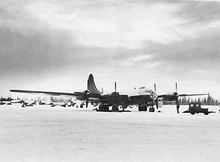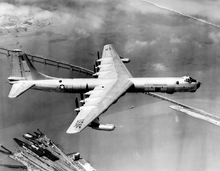72d Test and Evaluation Squadron
72d Test and Evaluation Squadron
 | |
|---|---|
|
B-2 Spirit landing at Whiteman AFB | |
| Active | 1918–1919; 1923–1947; 1947–1963; 1994-1996; 1998–present |
| Country |
|
| Branch |
|
| Role | Weapon system testing and evaluation |
| Part of | Air Combat Command |
| Garrison/HQ | Whiteman Air Force Base |
| Engagements |
World War I World War II |
| Decorations |
Distinguished Unit Citation Navy Presidential Unit Citation Air Force Outstanding Unit Award Philippine Presidential Unit Citation |
| Insignia | |
| 72d Test and Evaluation Squadron emblem (approved 14 February 1924)[1] |
 |





The 72d Test and Evaluation Squadron (72 TES) is part of the 53d Wing at Eglin Air Force Base, Florida. The squadron is geographically separated but operated from Whiteman Air Force Base, Missouri. It conducts testing and evaluation of the B-2 Spirit aircraft.
Mission
The squadron is the focal point for executing operational test and evaluation of the $44.6 billion B-2 weapon system. The squadron evaluates the ability of the B-2 weapons system to support all major requirements and reports weapon system capabilities.
The unit provides experienced operations, maintenance, engineering, and analysis personnel who plan and conduct ground and flight tests, and analyze, evaluate, and report on the effectiveness and suitability of B-2 logistics support, tactics and survivability, foreign military exploitation, weapons and mission planning. The squadron reports results and conclusions to support DoD acquisition, deployment and employment decisions.[2]
History
World War I
The squadron was formed in Texas in early 1918. After a period of training and organization, it departed from New York in the late summer of 1918, arriving in France in September. Its role during the latter part of World War I on the western front is undetermined, but it remained in France after the armistice until June 1919, arriving back in New York and subsequently demobilized in July.[1]
Interwar years
Reorganized in 1923 as a reconnaissance squadron, assigned to 5th Composite Group in Hawaii Territory as part of the islands air defense organization. Assigned to Hawaii on Ford Island. Activities included training, participating in Army-Navy maneuvers, staging aerial reviews and sowing seeds from the air for the Territorial Forestry Division. In 1935, the squadron helped save the city of Hilo, Hawaii, during the eruption of the Mauna Loa volcano. Ten Keystone B-3 and B-4 bombers from the group’s 23d and 72d Bombardment Squadrons dropped 20, 600-pound bombs around the volcano to divert molten lava away from the town.[1]
World War II
When the Navy moved its Pacific Fleet from San Diego to Pearl Harbor in 1939, moved to Hickam Field. Was equipped with a mixture of B-18 Bolos and early B-17C/D Flying Fortresses in 1941 when the Japanese attacked Hawaii. The group suffered devastating personnel and aircraft losses in the Pearl Harbor Attack, remaining in Hawaii until September 1942 re-equipping.[1]
Deployed to the South Pacific, engaging in long-range bombing of enemy targets in the Solomon Islands and Central Pacific using Very Long-Range B-24 Liberators. participating in MacArthur's island-hopping campaign in New Guinea and the Dutch East Indies. Participated in the Philippines Campaign, earning a Philippine Presidential Unit Citation for its actions in combat, 1944–1945. Inactivated at Clark Field, 1947 although most personnel had already returned to the United States.[1]
Strategic reconnaissance
Reactivated at Ladd Field, Alaska in 1947 assuming the mission, personnel and equipment of the 46th Reconnaissance Squadron with a mission to conduct strategic reconnaissance operations over the Arctic. The squadron's reconnaissance missions included electronic and weather monitoring flights used to track Soviet activities in the area. Between 1948-1949 the Boeing RB-29 Superfortresses of the 72nd SRS conducted numerous photographic reconnaissance and ELINT missions over the Soviet Arctic and Far East. Equipped with cameras that enabled then to remain in international airspace, whilst photographing targets deep inside Soviet territory, the aircraft searched for evidence of Soviet military activity, but unsurprisingly, found little going on in the inhospitable Arctic wastes but nobody knew what was happening further inland. To investigate activity deeper inside the Soviet Union, some RB-29s were stripped of all unnecessary equipment, allowing them to increase their operating ceiling, and began overflying Soviet territory.[3]
President Harry Truman, authorized the first overflight on 5 August 1948 when an RB-29 took off from Ladd AFB and, after routing over Siberia and spending over 19 hours in the air, eventually landed at Yokota Air Base, Japan. Even longer flights soon became routine with aircraft operating up to 35,000 ft, covering 5000 miles and remaining airborne for occasionally up to 30 hours. Although the Soviet Military was equipped rudimentary radar, copied from World War II US supplied equipment, large gaps existed in their radar coverage, particularly over the vast Arctic region. These gaps were soon identified and exploited by the RB-29s as they penetrated deeper inside the Soviet Union. Although they were detected on many occasions, none of the RB-29s was ever intercepted because the early MiG-15 was the only fighter with sufficient performance to reach these high-flying aircraft and none of the new fighters were then stationed in Siberia.[3]
The most significant of these missions included one on 3 September 1949 which identified the first evidence of a successful explosion of a Soviet nuclear weapon in the Semipalatinsk test site in Eastern Kazakhstan on 29 August 1949.[3]
Strategic bombardment
Moved to the Continental United States in 1951, being re-equipped with Very Long Range RB-36H Peacemaker strategic reconnaissance bombers and assigned to the 5th Strategic Reconnaissance Wing at Fairfield-Suisun Air Force Base, California. The aircraft were equipped with four J47 jet engines and with fourteen K-17C, K-22A, K-38, and K-40 cameras. It also received some advanced electronics. Its normal crew was 22, which included 5 gunners to man the 16 M-24A-1 20-mm cannon. Conducted global strategic reconnaissance until 1955, conducting ELINT and Ferret missions along the east Asian coastline. Gradually shifting to bombardment training mission beginning in 1954 as the 72d Bombardment Squadron, Heavy, on 1 October 1955.[3]
Flew B-36Js heavy bombers until their phaseout in 1958, being reassigned to the 4134th Strategic Wing, being re-equipped with B-52F Stratofortress intercontinental heavy bombers. Was reassigned to Mather Air Force Base, California by SAC to disperse its heavy bomber force. Conducted worldwide strategic bombardment training missions and providing nuclear deterrent. Was inactivated in 1963 when SAC inactivated its provisional Strategic Wings, redesignating them permanent Air Force Wings. Squadron was inactivated with its aircraft, personnel and equipment being transferred to the 441st Bombardment Squadron.[1]
Reactivated as a B-52H heavy bomb squadron at Minot Air Force Base, North Dakota in late 1994, but inactivated on 1 July 1996.
Test and evaluation
Reactivated as a B-2 Spirit stealth bomber evaluation squadron in 1998.[1]
Lineage
- 72d Aero Squadron
- Organized as the 72d Aero Squadron on 18 February 1918
- Demobilized on 11 July 1919
- Reconstituted and consolidated with the 72d Bombardment Squadron' as the 72d Bombardment Squadron on 8 April 1924[1][4]
- 72d Test and Evaluation Squadron
- Constitued as the 72d Bombardment Squadron on 6 February 1923
- Activated on 1 May 1923
- Consolidated with the 72d Aero Squadron pm 8 April 1924[4]
- Redesignated 72d Bombardment Squadron (Medium) on 6 December 1939
- Redesignated 72d Bombardment Squadron (Heavy) on 20 November 1940
- Redesignated 72d Bombardment Squadron, Heavy on 6 March 1944
- Redesignated 72d Bombardment Squadron, Very Heavy on 30 April 1946
- Inactivated on 10 March 1947
- Redesignated 72d Reconnaissance Squadron, Very Long Range, Photographic on 16 September 1947
- Activated on 13 October 1947
- Redesignated 72d Strategic Reconnaissance Squadron, Photographic on 23 February 1949
- Redesignated 72d Strategic Reconnaissance Squadron, Heavy on 14 November 1950
- Redesignated 72d Bombardment Squadron, Heavy on 1 October 1955
- Discontinued, and inactivated on 1 February 1963
- Redesignated 72d Bomb Squadron on 30 November 1994
- Activated on 1 December 1994
- Inactivated on 1 July 1996
- Redesignated 72d Test and Evaluation Squadron on 1 November 1998
- Activated on 20 November 1998[1]
Assignments
- Unknown, 18 February–September 1918
- 1st Air Depot, September 1918 – June 1919
- Unknown, June-11 July 1919
- 5th Composite Group, 1 May 1923
- 19th Bombardment Group
- Attached to: 5th Composite Group, 24 June 1932
- 5th Bombardment (later, 5th Reconnaissance) Group, 12 October 1938 – 10 March 1947
- Alaskan Air Command, 13 October 1947
- 311th Air Division, 1 April 1949
- 5th Strategic Reconnaissance Group, 28 June 1949
- Attached to: 5th Strategic Reconnaissance Wing, 10 February 1951 – 15 June 1952
- 5th Strategic Reconnaissance (later, 5th Bombardment) Wing, 16 June 1952
- 4134th Strategic Wing, 1 July 1958 – 1 February 1963
- 5th Operations Group, 1 December 1994 – 1 July 1996
- 53d Test and Evaluation Group, 20 November 1998 – present[1]
Stations
|
|
Aircraft
|
Operations
See also
References
![]() This article incorporates public domain material from the Air Force Historical Research Agency website http://www.afhra.af.mil/.
This article incorporates public domain material from the Air Force Historical Research Agency website http://www.afhra.af.mil/.
Notes
- 1 2 3 4 5 6 7 8 9 10 11 12 Warnock, A. Timothy (December 20, 2007). "Factsheet 72 Test and Evaluation Squadron (ACC)". Air Force Historical Research Agency. Retrieved October 22, 2016.
- ↑ 53 TEG Fact Sheet Archived 26 February 2009 at the Wayback Machine.
- 1 2 3 4 Wack, Fred J. The Secret Explorers: Saga of the 46th/72nd Reconnaissance Squadrons. N.p., 1990
- 1 2 Clay, p. 1424
Bibliography
- Clay, Steven E. (2011). US Army Order of Battle 1919-1941 (PDF). Vol. 3 The Services: Air Service, Engineers, and Special Troops 1919-1941. Fort Leavenworth, KS: Combat Studies Institute Press. ISBN 978-0-98419-014-0. LCCN 2010022326. OCLC 637712205. Retrieved October 16, 2012.
- Maurer, Maurer, ed. (1982) [1969]. Combat Squadrons of the Air Force, World War II (PDF) (reprint ed.). Washington, DC: Office of Air Force History. ISBN 0-405-12194-6. LCCN 70605402. OCLC 72556.
External links
- http://www.footnote.com/image/#19955883
- http://www.footnote.com/image/#19067086
- http://www.footnote.com/image/#21599334 1st air depot
| Wikimedia Commons has media related to 72d Test and Evaluation Squadron. |


